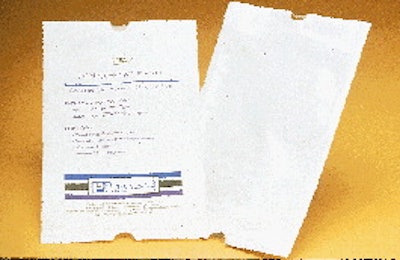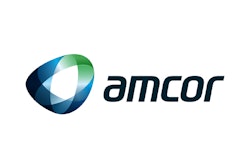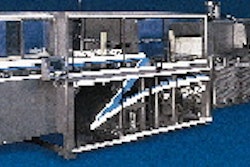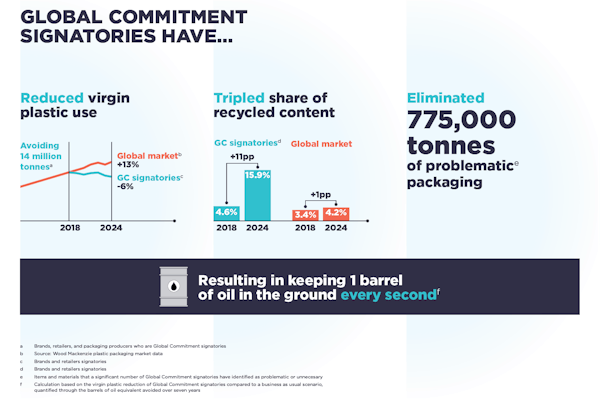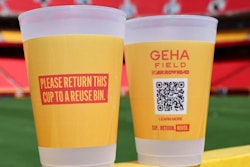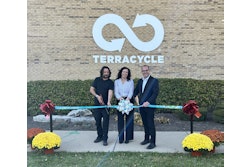Packaging for retail-oriented products and agricultural chemicals was well represented in this year's Flexible Packaging Association awards competition (see stories on p. 40 and p. 58). Rounding out the list of FPA winners were three entries that had little in common except relying on innovative combinations of materials to get its products to market. The most unusual of the three, and certainly the largest, is the foil/polyester bag (1) used by Heller Industries of Florham Park, NJ, to protect convection reflow ovens. These large ovens, used to manufacture printed circuit boards and costing more than $50ꯠ each, are at least 6' x 5' x 10'. Heller ships 400 to 500 of them globally each year via air or ocean freight. If these units are not protected from moisture and condensation, they begin to corrode, which leads to costly service calls for replacement of damaged components. Until last year, Heller protected its ovens with low-density polyethylene films containing a volatile corrosion inhibitor (VCI). This additive causes a chemical reaction that prevents corrosion, but only for a limited period. "We were getting numerous complaints from customers abroad concerning moisture retention that led to corrosion and damage," says Heller traffic manager Reynold Brown. The VCI films also were too labor intensive, adds Brown. Supplied in rolls, they had to be cut into pieces that were then laid out on the floor and taped together before being draped around the ovens. The wrapped ovens were then packed in wooden crates. Now used in place of the VCI films are the FPA award-winning premade bags supplied by LPS Industries (Moonachie, NJ). LPS makes the bags from laminated rollstock it receives from an unnamed converter in Europe. The rollstock structure is 48-ga polyester/extruded LDPE/ .005-mil foil/HDPE. For each bag, LPS workers cut four sheets from the roll and use a handheld clamp-style heat-seal device to seal four sheets together. These become the sidewalls of the bag and a fifth sheet becomes the top. Bottom sheets are shipped to Heller separately. At Heller, the first step in the packaging process is placement of a bottom sheet on the bottom of the wooden shipping crate. An operator then puts four bolts through holes in the crate bottom and through the foil-based sheet. A caulk-like tape is added to the area of the sheet where the bolts penetrate so that an air-tight barrier is assured. Next the oven is lowered by fork truck and secured to the bolts in the crate floor by O-rings and wing nuts. Then the premade bag is lowered over the oven manually and heat-sealed to the bottom sheet, again by means of the clamp-style tool. When three sides are sealed and moisture-absorbing desiccant packs have been added, an operator inserts a vacuum hose that evacuates ambient air inside the bag and oven. This minimizes the amount of oxygen present, thus reducing the possibility of condensation forming on the oven as it undergoes temperature fluctuations during an overseas journey. The evacuation is not total, however, because that would cause the material to cling too tightly and possibly tear on a sharp edge. Before the premade bags became available, it took Heller 50 to 60 minutes to prepare an oven for shipment. Now it takes 15. The overall appearance is improved, too, generating higher customer satisfaction. And the cost? "These bags are competitive," says Brown. "They may be 10 percent more than what we used before, but the payback is tenfold. We haven't received a single customer complaint since switching." Foiled again Another FPA winner that relies heavily on foil for product protection is the film used to package Press-in-Place(TM) Silicone Gasket Strips (2) from St. Paul-based 3M. Flexicon (Cary, IL) converts the multilayer structure, but detailed specs are considered proprietary by both Flexicon and 3M. Two years in the making, this product/package combo emerged from 3M surveys aimed at identifying what auto mechanics-who use gasket stripping on oil pans, valve covers, water pumps, etc.-wanted to see improved in the gasket package. 3M concluded that the two gasket stripping options available at the time both fell short. Preformed stripping, which is make- and model-specific, has to be carried in inventory or ordered when needed. As a result, too often it's not available when a customer's car requires it. The other option, which 3M employed itself before the new strips were developed, was a vulcanizing silicone system supplied in foil tubes. Not only are these messy, but residual silicone usually remains in the tube, resulting in waste and the need to dispose of the tube in a hazardous waste stream. 3M came up with a new kind of silicone gasket strip that's much easier to handle. It's produced in two sizes. The 6" strip is 1/8" in dia, the 12" strip is 1/4" in dia. These convenient strips can be used and shaped as needed. The mechanic opens the package and positions the strips as required. They can even be repositioned since they don't begin to cure for about 20 minutes after opening the package. The strips must be protected from moisture and oxygen immediately after manufacture or else they will begin to cure. So 3M devised what it calls a proprietary method of packaging in-line with product manufacturing. Flexicon isn't saying much about the award-winning film's makeup, though coextruded films and an adhesive lamination containing foil are mentioned. The bottom line is that the sensitive gasket material is hermetically sealed by heat and pressure yet the package can be easily peeled open when the time comes. "The product is still a vulcanizing silicone, it just has a different formulation," says 3M senior chemist Brian Ostlie. "Having formulated a brand new product, we wanted a package that was convenient, easy-to-open, and capable of protecting the gasket material from moisture." 3M introduced the new concept late last year and is rolling it out nationally. Medical device package Finally, in the medical device category, FPA judges recognized CPT polymeric sealant film (3) as a winner. The converter, a Bemis company, is Perfecseal (New London, WI). Unfortunately, the medical device manufacturer that benefits from the film's development chooses not to be identified. Perfecseal isn't saying much about the makeup of its material, either. What we do know is that CPT is a coextruded peelable sealant film designed to be heat-sealable to uncoated Tyvek® from DuPont (Wilmington, DE). Tyvek is the lidstock of choice for many medical device manufacturers who package their products between two plastic substrates for ethylene-oxide sterilization. The base substrate, which can be any one of several materials and can be thermoformed or not, keeps bacteria out. Tyvek does, too, but while its spun-bonded construction is a suitable barrier against bacteria, it still allows entry of the EtO sterilant. Because uncoated Tyvek can cause uneven seals, fiber pick-off from the Tyvek can occur when the package is peeled open. This contamination is unacceptable, so in most cases, Tyvek is precoated. But adding a coating to Tyvek is costly. That's where CPT comes in. When it's laminated to the base substrate, it provides uniform seal strength when Tyvek is heat-sealed to the base. Thus, even though the Tyvek is uncoated, no fiber pickoff occurs when the package is peeled open. A cohesive failure occurs. That is, part of the coextruded CPT stays on the film substrate and part goes with the Tyvek. At the same time, CPT's secure seal eliminates voids between the two substrates that can provide an opening for opportunistic bacteria. Other advantages of CPT, says Perfecseal, are improved machineability, visibility of seal integrity, and material cost savings. The material is more machineable because it can be heat-sealed to uncoated Tyvek at temperatures ranging from 240°F to 300°F. Seal integrity is visible to hospital personnel because cohesive failure causes a white border to be revealed in the seal area on the non-Tyvek substrate after the package is peeled open. If hospital personnel see any imperfection in that white border, they know immediately that sterility may be suspect. And finally, "significant" cost savings are gained, says Perfecseal, because coating of the Tyvek is eliminated.
